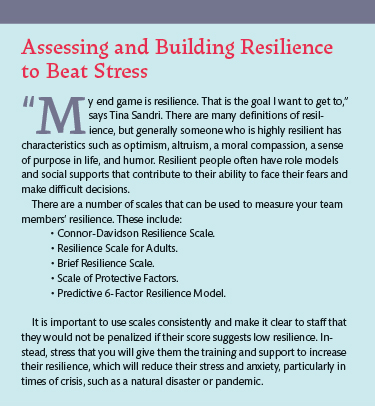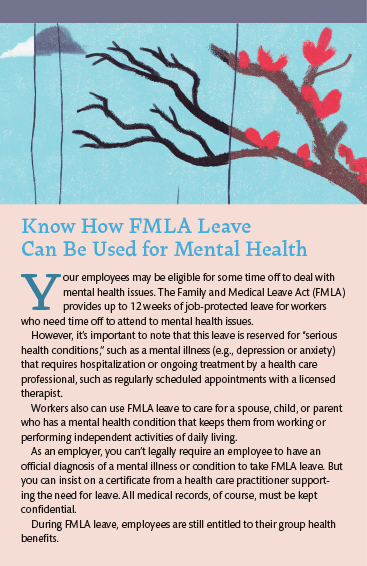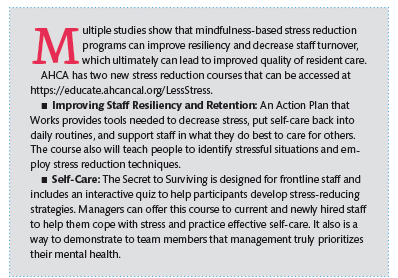Mental health issues haven’t disappeared as the pandemic has waned. In fact, team members at all levels continue to be plagued by depression, anxiety, stress, and post-traumatic stress disorder (PTSD), with a corresponding impact on productivity and staffing. Yet, many staff members are hesitant to seek help because they fear they will be judged or penalized, and others want help but don’t know where to get it. With the holidays here and a new year on the horizon, now is the time to identify and implement best practices and ensure person-centered mental health care and support for your teams.
Numbers Paint a Startling Picture
Today’s workers don’t see mental health care as just another benefit. According to an American Psychological Association (APA) survey, eight in 10 workers say an employer’s efforts to support mental health is a key factor in whether or not they’d be interested in taking a job with that organization.1 Specifically, they want benefits they see as conducive to mental health and wellbeing, such as more flexible work hours (41 percent), a workplace culture that respects time off (34 percent), and a four-day work week. While workers consistently express a desire for better wages, only 24 percent of workers in the APA survey said they don’t feel like they receive adequate compensation. Over two-thirds (71 percent) are worried about what inflation will do to their financial situation.
While your teams may want and need mental health support, they may hesitate to request or use these services. In one recent survey, 70 percent of employees said they thought their employers could improve their efforts to reduce mental health stigmas, and about a third said their employer doesn’t do a good job of promoting mental health resources or benefits.2
 Erasing the Stigmas
Erasing the Stigmas
“There is still a stigma about mental illness. We’ve made advances in the past 10-20 years, but people still feel hesitant to bring it up. This is true even though we are seeing a lot of depression and mental fatigue,” said Pamela Truscott, DNP/HSL, MSN/Ed, RN, QCP, DNS-CT, RAC-CT, CDP, director of quality improvement with NCAL. She stressed that destigmatizing mental health isn’t a one-and-done effort but also can’t be regulated or mandated through policy.
“Policies tend to be seen as related to regulations. It is likely to be more effective to encourage open discussions about mental health,” she said, adding, “be open about resources. Have a great employee assistance program (EAP), and make sure everyone knows what is available to them.” By frequently discussing mental health, this becomes the norm, and people will feel more comfortable talking about their feelings and seeking resources.
When employees come to a manager with a concern or problem, it is important to be empathetic and not judgmental. Understanding trauma-informed care can help. As Truscott observed, “each person has their own trauma, and we need to respect that.” For instance, someone who came from an abusive family situation might be traumatized by a resident having a loud argument with her daughter. If this person comes to you for help, it’s important to be empathetic even if you don’t understand why they’re upset.
 This means that instead of saying, “It’s not that bad. Just ignore it,” offer some support: “I understand how this is upsetting to you. Why don’t you take a break, or would you like to go somewhere and talk about it?”
This means that instead of saying, “It’s not that bad. Just ignore it,” offer some support: “I understand how this is upsetting to you. Why don’t you take a break, or would you like to go somewhere and talk about it?”
Tina Sandri, chief executive officer of Forest Hills of D.C., stressed, “we are living through a trauma that will affect us for years to come. We are still in a sustained battle. We need to be prioritizing ways to heal the body from trauma, and this calls for trauma-informed care for employees,” said Sandri. This needs to take into account that people have different coping mechanisms, and they think and digest information differently.
It is important to understand what will help you and others deal with trauma and short-circuit emotional responses. For instance, Sandri said, “our social worker came to me the other day and hugged me because she heard I might be upset. She knew that would be comforting for me because I’m a ‘hugger.’”
Sandri stressed, “we have to get a bit more emotionally intelligent about working with people through leadership training and listening skills.” Then, she suggested, instead of telling someone who is upset or agitated, “That’s not professional. Tone it down,” consider getting the person to a quiet space and asking, “What is concerning you right now?”
The things you do for residents to protect their mental health and wellbeing, you need to do for staff, said Truscott. “This has to be an ongoing priority and always on the table.”
Better Mental Health, Better Workspace
“Caring for the mental health of employees is an important workforce retention strategy,” said Truscott. Not every organization offers the same level of support for employees. However, there are numerous resources out there, so you don’t have to reinvent the wheel. For instance, AHCA is promoting mindfulness training. “We are offering tools and resources to people to handle any situation you find yourself in. We are all dealing with so much,” she said. “However, when workers have a variety of resources to use, they can find the ones that work for them, rebuild resilience, and gain perspective,” said Truscott.
 Some very helpful mental health supports are fairly simple. Truscott said, “deep breathing, taking a short walk outside or even just down the hall and back, or spending a few minutes in a quiet space can help.” It also can be useful for workers to have a colleague they can vent to. She added, “we need to help people use the resources they have to better manage stressful situations, to let go of the things they can’t control, and not to take on everyone’s problems.” When people own their situations and use tools and resources to move past them, they can be more optimistic and see the glass as half full.
Some very helpful mental health supports are fairly simple. Truscott said, “deep breathing, taking a short walk outside or even just down the hall and back, or spending a few minutes in a quiet space can help.” It also can be useful for workers to have a colleague they can vent to. She added, “we need to help people use the resources they have to better manage stressful situations, to let go of the things they can’t control, and not to take on everyone’s problems.” When people own their situations and use tools and resources to move past them, they can be more optimistic and see the glass as half full.
Mental health care for employees can’t just mean a binder that gets put on the shelf and collects dust.
“Your resources always have to be out there. Posters staff will see, in-service programs, articles in newsletters, eblasts, and more give you multiple and ongoing opportunities to remind staff what is available to them and to normalize mental health care.”
Short Circuit the Fight-Flight-Freeze Response
Sandri was thinking about how to short circuit the fight-flight-freeze response people have to a trauma or stressful situation. This was a particularly urgent concern during the pandemic. “I saw one staffer crying on the floor in a fetal position. Another person was hyperventilating and had to go to the hospital. The psychosocial burden health care workers picked up going into the fire of the pandemic to serve was significant,” she said.
 “We need person-centered care for our employees that looks at them as individuals. In doing this, we build a sense of community,” Sandri said. A certified yoga instructor, she decided that this needed to be a feature of a program for her staff. Elsewhere, she took her team out and did some ax throwing with a yoga-trained professional. Additionally, she said, “we have introduced an EAP and revamped our employee benefit handbook to include clear information about how to access the EAP and mental health benefits.”
“We need person-centered care for our employees that looks at them as individuals. In doing this, we build a sense of community,” Sandri said. A certified yoga instructor, she decided that this needed to be a feature of a program for her staff. Elsewhere, she took her team out and did some ax throwing with a yoga-trained professional. Additionally, she said, “we have introduced an EAP and revamped our employee benefit handbook to include clear information about how to access the EAP and mental health benefits.”
Sandri also uses a validated tool to help staff assess resilience. If they are feeling less resilient, they can then look at ways to support themselves, she noted, adding, “I am also offering eight weeks of mindfulness as online and in-person options to accommodate everyone who wants to participate.”
The efforts Sandri has put together for her team are her “own recipe” designed with her staff’s specific needs in mind. “We need to see, think, and feel the way our staff does and meet people where they are. We need to give them the help and support they need but also give them the space to be who they are.”
Sangita Lewis, OTR, senior vice president of sales at TMC, added, “for some people, giving them a raise will meet their needs; others just want some genuine recognition and one-on-one time with their leaders. We focus on being present. If you’re a supervisor, you can go out in the field and look at things from others’ viewpoints. We have an obligation to meet our staff’s emotional, mental, and spiritual needs and not just what they need to do their jobs.”
Sandri advised, “conduct a resiliency survey with staff and find out how resilient they are; listen and find out what their needs are. Don’t assume you know.” For instance, Sandri’s team discovered that her nursing staff wanted 12-hour shifts. This was a fairly simple change that made nurses happier. She said, “find out whether they will enjoy yoga or would rather have a dance party. Then meet people where they are.” She also suggested, “you also can work with health insurance and other partners to develop things like wellness programs.”
 Lewis offered, “one thing we’re doing well is going back to more live meetings. We think it’s important to see each other and interact in person. It is essential to stay engaged. We also have a monthly education day where different departments can share information and a program where our HR leaders are available during set times to talk and answer questions about mental health and other benefits. We also encourage leaders to get to know people and sense when something is ‘off’ or they need assistance,” she said. Finally, they promote physical wellness and financial wellbeing as well as mental health. For instance, they have a free financial wellness course to help people get out of debt and live a financially stable life.
Lewis offered, “one thing we’re doing well is going back to more live meetings. We think it’s important to see each other and interact in person. It is essential to stay engaged. We also have a monthly education day where different departments can share information and a program where our HR leaders are available during set times to talk and answer questions about mental health and other benefits. We also encourage leaders to get to know people and sense when something is ‘off’ or they need assistance,” she said. Finally, they promote physical wellness and financial wellbeing as well as mental health. For instance, they have a free financial wellness course to help people get out of debt and live a financially stable life.
It’s Okay Not to Be Perfect
“First thing, we need to admit that we’re not doing everything right, even though we all want to do the right thing. A key part of being a good employer is acknowledging that we can always do better,” said Lewis. “Everyone is going through something. Employers have to do a better job of caring for staff.” This has to be an ongoing grassroots effort, she said, adding, “We have to talk about it constantly, and communicate in an honest, caring way. That is a foundational piece that is expected of all of us as leaders.” This needs to be part of the organization’s core values and DNA.
References
1 https://www.apa.org/news/press/releases/ 2022/07/workplaces-mental-health-supports
2 https://www.hrdive.com/news/employers-could-do-more-to-reduce-mental-health-stigma-year-round-workers/626848/